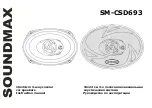
10
EN
11
ADAPTING THE SOUND OUTPUT
In order to adapt the new
AURUM 9
series individually to your living room conditions without distorting the
perfect sound character,
all models are at least fitted with a high frequency switch (HIGH).
High range switch (HIGH)
HIGH +
In the high range, plus 2dB means an overall higher tonal level. This is worthwhile for very heavily insulated
rooms and for everyone who wants to hear a bit more “analytically”. It can be a special advantage when
enjoying soft music, because the frequency-response curve is adjusted to hearing at a low level.
HIGH -
This switch setting makes sense in very hall-like rooms or at high listening volumes, because the frequency
response in the high range is adjusted to the hearing curve at higher volumes.
The models
AURUM TITAN 9. VULKAN 9
and
TITAN BASE 9
are also fitted with a mid range tone and low
tone filter switch.
Midrange switch (MID)
MID -
This lowers the volume in the listening area. In hall-like spaces, this can eliminate some midrange penetration.
However, this switch setting can also simply be used as a matter of taste.
MID +
The midrange plus 2dB setting makes the fundamental tone range a bit warmer. For rooms with selectively
heavy insulation, this can make the sound altogether more balanced and warmer.
Low tone filter switch (LOW)
LOW N
The neutral setting (N) set as standard in the delivery condition offers ideally structured bass reproduction for
this loudspeaker.
LOW +
The LOW+ switch raises the middle bass range by between about 40 Hz and 100 Hz. In very large rooms this
can lead to a desirable increase in full bass and pressure.
BEWARE OF CLIPPING!
Even if an amplifier’s nominal output is significantly lower than the rated power-handling capacity of the
speakers connected to it, there is still every possibility that the speakers might be damaged if not used
correctly. The nominal output quoted merely indicates the number of watts the amplifier is capable of
delivering to the speakers with low distortion. If an amplifier is overloaded it delivers far more power on
the one hand while adding destructive direct current as well as high-frequency oscillation on the other. This
process is known as clipping and negatively affects the sound through severe distortion in loud passages of
music. When distortion becomes audible you should turn the volume down straight away to avoid damaging
the speakers. Amp-clipping is a typical indication of overloading and always occurs when the volume and/or
tone controls is/are turned up too high. Even when the tone controls are set in neutral (12 o’clock) position,
conventional amps already reach their limits when subject to loud impulses as soon as the volume control is
turned well beyond the 12 o’clock position.
CARE OF YOUR LOUDSPEAKERS
Your
AURUM
loudspeakers are best cleaned with a soft, dry cloth. Do not use solvents.
You should only clean the loudspeaker systems (woofer, midrange units) when they have become very dirty
(small amounts of dust have no effect on the acoustics). Use a soft, dry cloth or a soft brush with very gentle
pressure, otherwise there is a risk of damaging the diaphragms.
We strongly advise against cleaning the ribbon tweeter, because this special transducer reacts with extreme
sensitivity to compressed air and drafts and may be damaged. Therefore the ribbon tweeter must never be
cleaned with a vacuum cleaner. The front opening must also not be blown off!
We accept no liability for improper cleaning of the speaker.
Slight soiling on the fabric front frame can be removed by tapping, with a vacuum cleaner, or by using an
adhesive tape when the front frame has been removed.
Heavier soil can be removed with a dry foam cleaner (such as Centralin spray). Never use moisture to clean
the front frame.
The technical details for your product can be found on the back of the speaker cabinet!
Should you have any questions, please contact us on tel.: +49 (0) 511 7904-0,
e-mail: [email protected] or [email protected]







































